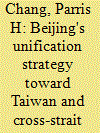| Srl | Item |
| 1 |
ID:
164202


|
|
|
|
|
| Summary/Abstract |
FOR SEVERAL MONTHS, the world expert community has been actively discussing the obvious resurgence of the Russia-the U.S.-China "triangle." This happens every time when the key, or even "sacral," problem of international interaction - the problem of security - comes to the fore. The high level of confrontation inside two of the three sides of the "triangle" - the U.S. vs. Russia and China vs. the U.S. - predetermined this resurgence against the background of Donald Trump's non-orthodox and unyielding foreign policy.
|
|
|
|
|
|
|
|
|
|
|
|
|
|
|
|
| 2 |
ID:
134077


|
|
|
|
|
| Publication |
2014.
|
| Summary/Abstract |
For almost a decade, Beijing has pursued a "soft" approach toward Taiwan, cultivating economic ties and political exchanges in its pursuit of reunification. Following the end of President Chen Shui-bian's term in office, which was marked by constant tensions and several crises with China, Beijing has colluded with his successor, Ma Ying-jeou to pursue a policy of economic integration with the mainland. Beijing's
strategy toward Taiwan under Chairman Xi Jinping and his predecessor Hu Jintao has yielded positive results. The approach not only avoids possible military conflict with the United States, but receives support from Washington. Beijing's economic means, such as the Economic Cooperation Framework Agreement (ECFA), have enhanced Taiwan's economic integration with China and greatly increased the
PRC's control over Taiwan's economy and society, helping to lock Taiwan into the mainland's orbit. Likewise, Beijing has developed tools that allow it to intervene directly in Taiwanese domestic politics. However, efforts to use ties with President Ma to bring Taiwan farther into the PRC orbit have backfired, resulting in a weakened presidency that cannot deliver Beijing's goals. Thus, Beijing appears to be looking ahead to the next two elections, trying to make as much progress as possible before Ma leaves office, while simultaneously trying to establish ties with possible successors and the opposition DPP. In 2012, Beijing's intervention assisted the reelection of President Ma. It is sure to try again in Taipei's mayoral election in 2014 and the presidential/parliamentary elections in 2016.
|
|
|
|
|
|
|
|
|
|
|
|
|
|
|
|
| 3 |
ID:
167735


|
|
|
|
|
| Summary/Abstract |
During the 20th century, relations between the United States and China underwent major changes several times. They went from the United States' opposing Japanese aggression in China in the 1930s, based on the U.S.A.'s Open Door policy; to a close military and political alliance in the 1940s, including recognition of China as a great power; and finally, to refusing to recognize the People's Republic of China in the early 1950s and adopting a policy of containment and isolation. The dead end in relations between the two countries was opened by U.S. President Richard Nixon's visit to China in 1972 and the concurrent signing of the Shanghai Communique.
|
|
|
|
|
|
|
|
|
|
|
|
|
|
|
|